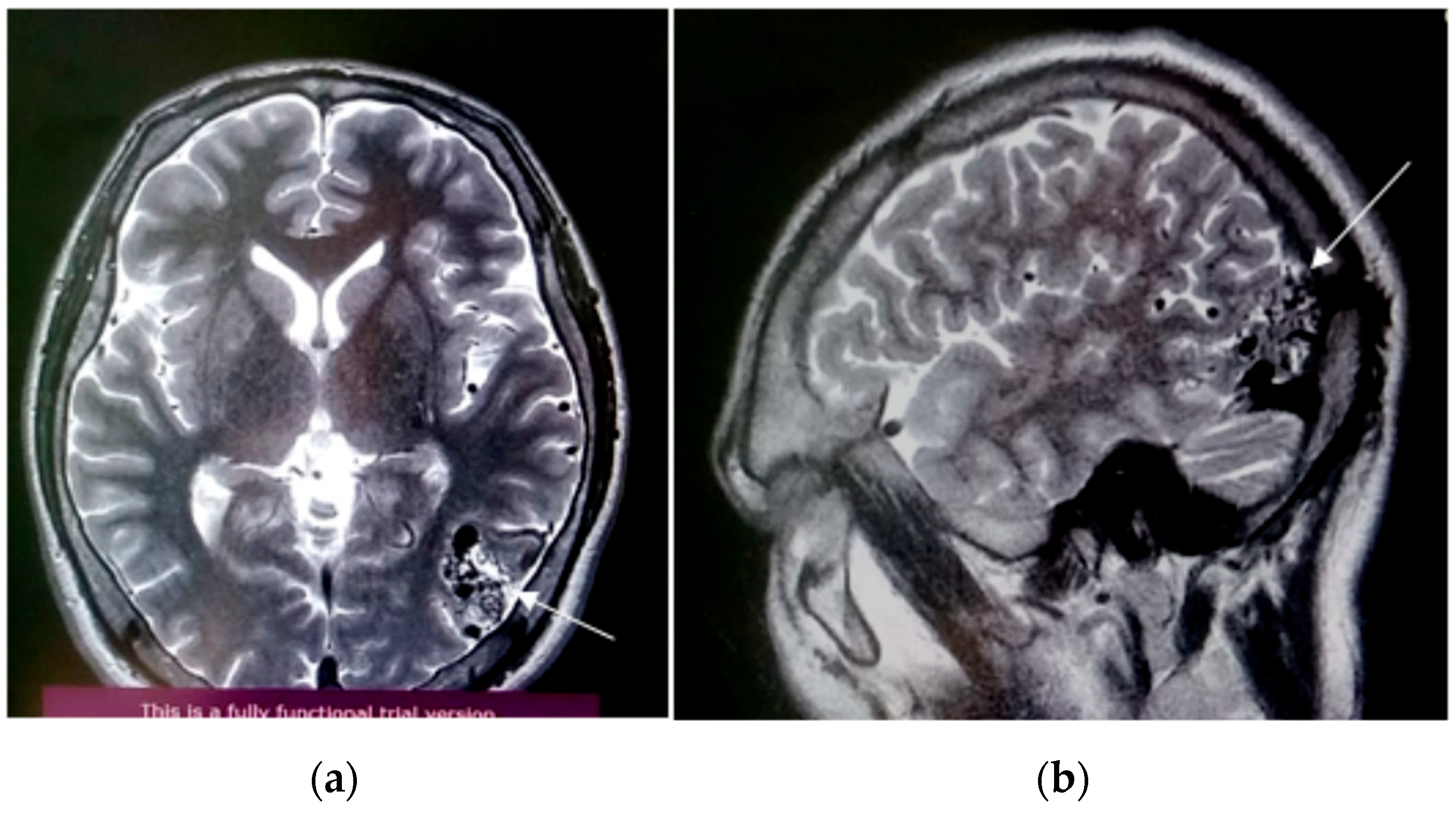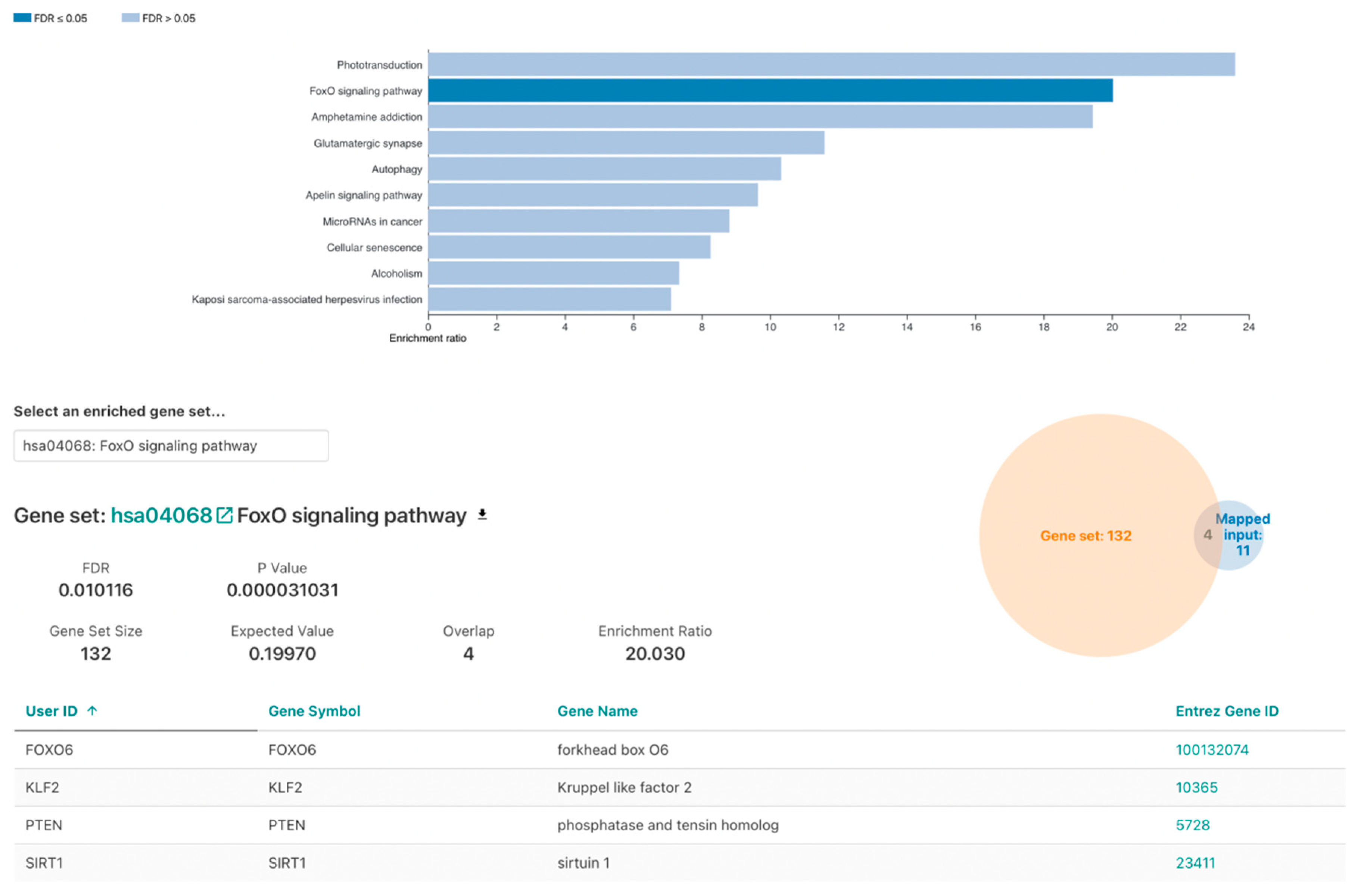Whole-Exome Sequencing Reveals Pathogenic SIRT1 Variant in Brain Arteriovenous Malformation: A Case Report
Abstract
:1. Introduction
2. Materials and Methods
2.1. Data Collection
2.2. DNA Isolation
2.3. Whole Exome Sequencing (WES)
2.4. WES Data Processing
2.5. Gene Ontology (GO), Disease and Pathway Over-Representation Analysis (ORA)
2.6. Mutation Validation
3. Results
3.1. Case Presentation and Surgical Procedure
3.2. WES Results Analysis
3.3. Over-Representation Analysis
3.4. FOXO Signaling Pathway
4. Discussion
Supplementary Materials
Author Contributions
Funding
Institutional Review Board Statement
Informed Consent Statement
Data Availability Statement
Conflicts of Interest
References
- Laakso, A.; Hernesniemi, J. Arteriovenous malformations: Epidemiology and clinical presentation. Neurosurg. Clin. N. Am. 2012, 23, 1–6. [Google Scholar] [CrossRef] [PubMed]
- Dalton, A.; Dobson, G.; Prasad, M.; Mukerji, N. De novo intracerebral arteriovenous malformations and a review of the theories of their formation. Br. J. Neurosurg. 2018, 32, 305–311. [Google Scholar] [CrossRef] [PubMed]
- Bharatha, A.; Faughnan, M.E.; Kim, H.; Pourmohamad, T.; Krings, T.; Bayrak-Toydemir, P.; Pawlikowska, L.; McCulloch, C.E.; Lawton, M.T.; Dowd, C.F.; et al. Multiplicity of brain arteriovenous malformations predicts the diagnosis of hereditary hemorrhagic telangiectasia. Stroke 2012, 43, 72–78. [Google Scholar] [CrossRef] [PubMed]
- Yılmaz, B.; Toktaş, Z.O.; Akakın, A.; Işık, S.; Bilguvar, K.; Kılıç, T.; Günel, M. Familial occurrence of brain arteriovenous malformation: A novel ACVRL1 mutation detected by whole exome sequencing. J. Neurosurg. 2017, 126, 1879–1883. [Google Scholar] [CrossRef] [PubMed]
- Komiyama, M. Pathogenesis of brain arteriovenous malformations. Neurol. Med. Chir. 2016, 56, 317–325. [Google Scholar] [CrossRef] [PubMed]
- Parambil, J.G. Hereditary hemorrhagic telangiectasia. Clin. Chest Med. 2016, 37, 513–521. [Google Scholar] [CrossRef]
- Eerola, I.; Boon, L.M.; Mulliken, J.B.; Burrows, P.E.; Dompmartin, A.; Watanabe, S.; Vanwijck, R.; Vikkula, M. Capillary malformation-arteriovenous malformation, a new clinical and genetic disorder caused by RASA1 mutations. Am. J. Hum. Genet. 2003, 73, 1240–1249. [Google Scholar] [CrossRef]
- Pabaney, A.H.; Rammo, R.A.; Tahir, R.A.; Seyfried, D. Development of de novo arteriovenous malformation following ischemic stroke: Case report and review of current literature. World Neurosurg. 2016, 96, 608.e5–608.e12. [Google Scholar] [CrossRef]
- Weinsheimer, S.; Bendjilali, N.; Nelson, J.; Guo, D.E.; Zaroff, J.G.; Sidney, S.; McCulloch, C.E.; Al-Shahi Salman, R.; Berg, J.N.; Koeleman, B.P.; et al. Genome-wide association studies of sporadic brain arteriovenous malformations. J. Neurol. Neurosurg. Psychiatry 2016, 87, 916–923. [Google Scholar] [CrossRef]
- Thomas, J.M.; Surendran, S.; Abraham, M.; Rajavelu, A.; Chandrasekharan, C. Kartha genetic and epigenetic mechanisms in the development of arteriovenous malformations in the brain. Clin. Epigenet. 2016, 8, 78. [Google Scholar] [CrossRef] [Green Version]
- Nikolaev, S.I.; Vetiska, S.; Bonilla, X.; Boudreau, E.; Jauhiainen, S.; Rezai Jahromi, B.; Khyzha, N.; DiStefano, P.V.; Suutarinen, S.; Kiehl, T.R.; et al. Somatic activation of KRAS mutations in arteriovenous malformations in the brain. N. Engl. J. Med. 2018, 378, 250–261. [Google Scholar] [CrossRef]
- Hong, T.; Yan, Y.; Li, J.; Radovanovic, I.; Ma, X.; Shao, Y.W.; Yu, J.; Ma, Y.; Zhang, P.; Ling, F.; et al. High prevalence of KRAS/BRAF somatic mutations in brain and spinal cord arteriovenous malformation. Brain 2019, 142, 23–34. [Google Scholar] [CrossRef] [PubMed]
- Walcott, B.P.; Winkler, E.A.; Zhou, S.; Birk, H.; Guo, D.; Koch, M.J.; Stapleton, C.J.; Spiegelman, D.; Dionne-Laporte, A.; Dion, P.A.; et al. Identification of a rare BMP pathway mutation in a non-syndromic human brain arteriovenous malformation using exome sequencing. Hum. Genome Var. 2018, 5, 18001. [Google Scholar] [CrossRef] [PubMed]
- Sauve, A.A.; Wolberger, C.; Schramm, V.L.; Boeke, J.D. Bbiochemistry of the sirtuins. Annu. Rev. Biochem. 2006, 75, 435–465. [Google Scholar] [CrossRef] [PubMed]
- Michishita, E.; Park, J.Y.; Burneskis, J.M.; Barrett, J.C.; Horikawa, I. Evolutionarily conserved and non-conserved cellular localizations and functions of human SIRT proteins. Mol. Biol. Cell 2005, 16, 4623–4635. [Google Scholar] [CrossRef]
- Cheng, H.L.; Mostoslavsky, R.; Saito, S.; Manis, J.P.; Gu, Y.; Patel, P.; Bronson, R.; Appella, E.; Alt, F.W.; Chua, K.F. Developmental defects and p53 hyperacetylation in Sir2 homolog (SIRT1)-deficient mice. Proc. Natl. Acad. Sci. USA 2003, 100, 10794–10799. [Google Scholar] [CrossRef]
- Nakagawa, T.; Guarente, L. Sirtuins. J. Cell Sci. 2011, 124, 833–838. [Google Scholar] [CrossRef]
- Man, A.W.; Li, H.; Xia, N. Role of Sirtuin1 in regulating endothelial function, arterial remodeling, and vascular aging/front physiology. Front. Physiol. 2019, 10, 1173. [Google Scholar] [CrossRef]
- Libert, S.; Pointer, K.; Bell, E.L.; Das, A.; Cohen, D.E.; Asara, J.M.; Kapur, K.; Bergmann, S.; Preisig, M.; Otowa, T.; et al. SIRT1 activates MAO-A in the brain to mediate anxiety and exploratory drive. Cell 2011, 147, 1459–1472. [Google Scholar] [CrossRef]
- Abuzenadah, A.; Al-Saedi, S.; Karim, S.; Al-Qahtani, M. Role of Overexpressed Transcription Factor FOXO1 in Fatal Cardiovascular Septal Defects in Patau Syndrome: Molecular and Therapeutic Strategies. Int. J. Mol. Sci. 2018, 19, 3547. [Google Scholar] [CrossRef] [Green Version]
- Dagra, A.; Williams, E.; Aghili-Mehrizi, S.; Goutnik, M.A.; Martinez, M.; Turner, R.C. Lucke-Wold B Pediatric Subarachnoid Hemorrhage: Rare Events with Important Implications. Brain Neurol. Disord. 2022, 5, 20. [Google Scholar] [CrossRef]
- Potente, M.; Ghaeni, L.; Baldessari, D.; Mostoslavsky, R.; Rossig, L.; Dequiedt, F.; Haendeler, J.; Mione, M.; Dejana, E.; Alt, F.W.; et al. SIRT1 controls endothelial angiogenic function during vascular growth. Genes Dev. 2007, 21, 2644–2658. [Google Scholar] [CrossRef] [PubMed]
- Kim, S.Y.; Ko, Y.S.; Park, J.; Choi, Y.; Park, J.-W.; Kim, Y.; Pyo, J.S.; Yoo, Y.B.; Lee, J.S.; Lee, B.L. Forkhead Transcription Factor FOXO1 Inhibits Angiogenesis in Gastric Cancer in Relation to SIRT1. Cancer Res. Treat. 2016, 48, 345–354. [Google Scholar] [CrossRef] [PubMed] [Green Version]




| AVM | Blood | |
|---|---|---|
| Capture method | Agilent SureSelect Human All Exon V6 | |
| Mean coverage | ||
| % > 10× | 99.0 | 98.8 |
| % > 20× | 97.0 | 96.3 |
| % > 30× | 93.6 | 92.1 |
| Primer | Sequence (5′–3′) | Ta (°C) | Amplicon Length (bp) |
|---|---|---|---|
| SIRT_F | GACCCGTAGTGTTGTGGTCT | 64 | 558 |
| SIRT_R | TCGTCTTCGTCGTACAAGTTGTC | 64 |
| N | Chr | Position | SNP | Gene | REF | ALT | Type | Blood | Tissue |
|---|---|---|---|---|---|---|---|---|---|
| 1 | chr1 | 41847882 | rs373524987 | FOXO6 | CA | - | frameshift deletion | 0/1 | 1/1 |
| 2 | chr1 | 41847886 | FOXO6 | C | G | nonsynonymous SNV | 0/1 | 1/1 | |
| 3 | chr10 | 89623901 | rs2943772 | PTEN | G | C | nonsynonymous SNV | / | 1/1 |
| 4 | chr20 | 56803624 | rs146771462 | ANKRD60 | G | C | nonsynonymous SNV | 1/1 | 0/0 |
| 5 | chr3 | 75786555 | rs141276988 | ZNF717 | - | TG | frameshift insertion | 0/1 | 0/0 |
| 6 | chr3 | 112253058 | rs35560667 | ATG3 | - | A | frameshift insertion | 0/1 | 1/1 |
| 7 | chr1 | 1355796 | rs145378993 | ANKRD65 | C | T | nonsynonymous SNV | 0/1 | 0/0 |
| 8 | chr10 | 69644589 | rs548590752 | SIRT1 | C | T | nonsynonymous SNV | 0/0 | 0/1 |
| 9 | chr16 | 72042682 | rs3213422 | DHODH | A | C | nonsynonymous SNV | 0/1 | 1/1 |
| 10 | chr17 | 16256681 | rs188652843 | CENPV | G | A | nonsynonymous SNV | 1/1 | 0/1 |
| 11 | chr19 | 1000785 | rs12986002 | GRIN3B | C | T | nonsynonymous SNV | 1/1 | 0/1 |
| 12 | chr19 | 16436376 | rs3745319 | KLF2 | G | A | nonsynonymous SNV | 0/0 | 0/1 |
| 13 | chr2 | 26407937 | rs181971256 | GAREM2 | A | G | nonsynonymous SNV | 0/0 | 0/1 |
| 14 | chr2 | 100938226 | rs74177694 | LONRF2 | G | C | nonsynonymous SNV | / | 1/1 |
| 15 | chr2 | 100938481 | rs74177696 | LONRF2 | C | G | nonsynonymous SNV | 0/0 | 0/1 |
| 16 | chr2 | 128459214 | rs10206957 | SFT2D3 | C | G | nonsynonymous SNV | 1/1 | 0/1 |
| 17 | chr2 | 202410300 | rs10804117 | C2CD6 | A | T | nonsynonymous SNV | 0/0 | 0/1 |
| 18 | chr22 | 18923745 | rs2008720 | PRODH | G | T | nonsynonymous SNV | 0/0 | 0/1 |
| 19 | chr22 | 19137658 | rs34341950 | GSC2 | G | A | nonsynonymous SNV | 1/1 | 0/1 |
| 20 | chr3 | 75788076 | rs146581110 | ZNF717 | A | C | nonsynonymous SNV | / | 1/1 |
| 21 | chr3 | 75788085 | rs201605431 | ZNF717 | A | G | nonsynonymous SNV | / | 1/1 |
| 22 | chr3 | 75788105 | rs796745611 | ZNF717 | C | T | nonsynonymous SNV | / | 1/1 |
| 23 | chr3 | 75788109 | rs796849627 | ZNF717 | G | A | nonsynonymous SNV | / | 1/1 |
| 24 | chr3 | 75788130 | rs113708852 | ZNF717 | C | T | nonsynonymous SNV | / | 1/1 |
| 25 | chr3 | 75788137 | rs199883677 | ZNF717 | C | T | nonsynonymous SNV | / | 1/1 |
| 26 | chr3 | 184017075 | rs182086670 | PSMD2 | C | G | nonsynonymous SNV | 0/1 | 1/1 |
| 27 | chr4 | 80905990 | rs12647691 | ANTXR2 | C | G | nonsynonymous SNV | 1/1 | 0/1 |
| 28 | chr6 | 42075069 | rs55772414 | C6orf132 | A | G | nonsynonymous SNV | 0/1 | 1/1 |
| 29 | chr7 | 93540153 | rs17243826 | GNGT1 | G | C | nonsynonymous SNV | 1/1 | 0/1 |
| 30 | chr8 | 8750243 | MFHAS1 | A | G | nonsynonymous SNV | 0/0 | 0/1 |
Publisher’s Note: MDPI stays neutral with regard to jurisdictional claims in published maps and institutional affiliations. |
© 2022 by the authors. Licensee MDPI, Basel, Switzerland. This article is an open access article distributed under the terms and conditions of the Creative Commons Attribution (CC BY) license (https://creativecommons.org/licenses/by/4.0/).
Share and Cite
Mukhtarova, K.; Zholdybayeva, E.; Kairov, U.; Akhmetollayev, I.; Nurimanov, C.; Kulmirzayev, M.; Makhambetov, Y.; Ramankulov, Y. Whole-Exome Sequencing Reveals Pathogenic SIRT1 Variant in Brain Arteriovenous Malformation: A Case Report. Genes 2022, 13, 1689. https://doi.org/10.3390/genes13101689
Mukhtarova K, Zholdybayeva E, Kairov U, Akhmetollayev I, Nurimanov C, Kulmirzayev M, Makhambetov Y, Ramankulov Y. Whole-Exome Sequencing Reveals Pathogenic SIRT1 Variant in Brain Arteriovenous Malformation: A Case Report. Genes. 2022; 13(10):1689. https://doi.org/10.3390/genes13101689
Chicago/Turabian StyleMukhtarova, Kymbat, Elena Zholdybayeva, Ulykbek Kairov, Ilyas Akhmetollayev, Chingiz Nurimanov, Marat Kulmirzayev, Yerbol Makhambetov, and Yerlan Ramankulov. 2022. "Whole-Exome Sequencing Reveals Pathogenic SIRT1 Variant in Brain Arteriovenous Malformation: A Case Report" Genes 13, no. 10: 1689. https://doi.org/10.3390/genes13101689
APA StyleMukhtarova, K., Zholdybayeva, E., Kairov, U., Akhmetollayev, I., Nurimanov, C., Kulmirzayev, M., Makhambetov, Y., & Ramankulov, Y. (2022). Whole-Exome Sequencing Reveals Pathogenic SIRT1 Variant in Brain Arteriovenous Malformation: A Case Report. Genes, 13(10), 1689. https://doi.org/10.3390/genes13101689






